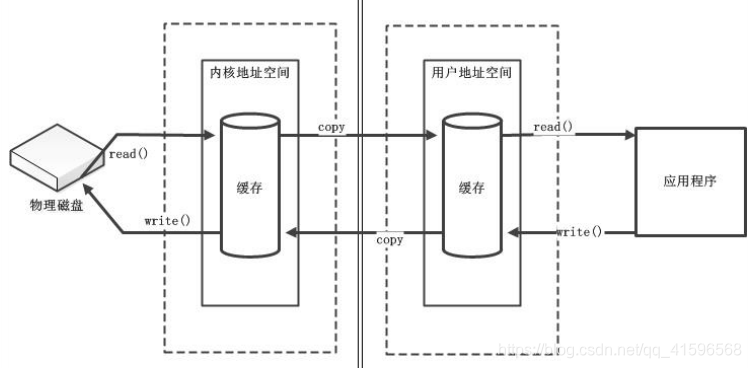文章目录
【笔记于学习尚硅谷课程所作】
1、Java NIO简介
Java NIO (New IO)是从Java 1.4版本开始引入的一个新的IO API,可以替代标准的Java IO API。
NIO与原来的IO有同样的作用和目的,但是使用的方式完全不同,NIO支 持面向缓冲区的、基于通道的IO操作。NIO将以更加高效的方式进行文件的读写操作。
| IO | NIO |
|---|---|
| 面向流 | 面向缓冲区 |
| 阻塞IO | 非阻塞IO |
| 无 | 选择器 |
2、缓冲区(Buffer)和通道(Channel)
Java NIO系统的核心在于:通道(Channel)和缓冲区(Buffer)。 通道表示打开到IO设备的连接。若需要使用NIO系统,需要获取用于连接IO设备的通道以及用于容纳数据的缓冲区。然后操作缓冲区,对数据进行处理。
简而言之,Channel(通道)负责传输,Buffer(缓冲区)负责存储
2.1 缓冲区(Buffer)
1.缓冲区(Buffer)
在Java NIO中负责数据的存取。缓冲区就是数组。用于存储不同数据类型的数据
//通过allocate获取缓冲区,分配一个指定大小的缓冲区
ByteBuffer buf = ByteBuffer.allocate(1024);
2.缓冲区的数据操作
- put():存入数据到缓冲区
- put(byteb):将给定单个字节写入缓冲区的当前位置
- put(byte[] src):将src中的字节写入缓冲区的当前位置
- put(int index, byte b):将指定字节写入缓冲区的索引位置(不会移动position)
- get():获取缓冲区中的数据
- get():读取单个字节
- get(byte[] dst):批量读取多个字节到dst中
- get(int index):读取指定索引位置的字节(不会移动position)
3.缓冲区的四个核心属性
-
容量(capacity):(最大存储容量)表示Buffer最大数据容量,缓冲区容量不能为负,并且创建后不能更改
-
限制(limit):(可以操作数据的大小)第一个不应该读取或写入的数据的索引,即位于limit后的数据不可读写。缓冲区的限制不能为负,并且不能大于其容量
-
位置(position):(正在操作数据的位置)下一个要读取或写入的数据的索引。缓冲区的位置不能为负,并且不能大于其限制
-
标记(mark)与重置(reset):标记是一个索引,通过Buffer中的mark()方法指定Buffer中一个特定的position,之后可以通过调用reset()方法恢复到这个position
标记、位置、限制、容量遵守以下不变式:
4.Buffer的常用方法
| 方法 | 描述 |
|---|---|
| Buffer clear () | 清空缓冲区并返回对缓冲区的引用 |
| Buffer flip() | 将缓冲区的界限设置为当前位置,并将当前位置充值为0 |
| int capacity() | 返回Buffer的capacity 大小 |
| boolean hasRemaining() | 判断缓冲区中是否还有元素 |
| int limit () | 返回Buffer 的界限(limit)的位置 |
| Buffer limit(int n) | 将设置缓冲区界限为n,并返回一个具有新limit的缓冲区对象 |
| Buffer mark() | 对缓冲区设置标记 |
| int position() | 返回缓冲区的当前位置position |
| Buffer position(int n) | 将设置缓冲区的当前位置为n,并返回修改后的Buffer 对象 |
| int remaining() | 返回position 和limit 之间的元素个数 |
| Buffer reset() | 将位置position 转到以前设置的mark 所在的位置 |
| Buffer rewind () | 将位置设为为0,取消设置 的mark |
5.直接缓冲区与非直接缓冲区
(1)非直接缓冲区:通过allocate()方法分配缓冲区,将缓冲区建立在JVM的内存中

(2)直接缓冲区:通过allocateDirect()方法分配直接缓冲区,将缓冲区建立在物理内存中。可以提高效率

3、文件通道(FileChannel)
通道(Channel) :用于源节点与目标节点的连接。在Java NIO中负责缓冲区中数据的传输。本身就是处理器,和DMA类似,不需要请求CPU
3.1 实现了 Channel接口的实现类
- FileChannel:用于读取、写入、映射和操作文件的通道。
- DatagramChannel:通过UDP 读写网络中的数据通道。
- SocketChannel:通过TCP读写网络中的数据。
- ServerSocketChannel:可以监听新进来的TCP连接,对每一个新进来的连接都会创建一个Socke tChannel。
3.2 获取通道的方法
- getChannel方法,支持这个方法的类有:
- (本地IO)FileInputStream、FileOutputStream、RandomAccessFile
- (网络IO)DatagramSocket、Socket、ServerSocket
- 在JDK1.7中的NI0.2针对各个通道提供了静态方法open()
- 在JDK 1.7中的NIO.2的Files工具类的newByteChanne1()
3.3 通道的数据传输
1.通道之间的数据传输(直接缓冲区)[重要]
@Test
public void test() throws IOException{
FileChannel inChannel = FileChannel.open(Paths.get("1.mkv"),StandardOpenOption.READ);
FileChannel outChannel = FileChannel.open(Paths.get("2.mkv"),StandardOpenOption.WRITE,StandardOpenOption.READ,StandardOpenOption.CREATE);
//inChannel.transferTo(0,inChannel.size(),outChannel);与下作用相同
outChannel.transferFrom(inChannel,0,inChannel.size());
inChannel.close();
outChannel.close();
}
2.使用内存映射文件(直接缓冲区)
@Test
public void test() throws IOException{
FileChannel inChannel = FileChannel.open(Paths.get("1.mkv"),StandardOpenOption.READ);
FileChannel outChannel = FileChannel.open(Paths.get("2.mkv"),StandardOpenOption.WRITE,StandardOpenOption.READ,StandardOpenOption.CREATE);
//内存映射文件
MappedByteBuffer inMappedBuf = inChannel.map(MapMode.READ_ONLY,0,inChannel.size());
MappedByteBuffer outMappedBuf = outChannel.map(MapMode.READ_WRITE,0,inChannel.size());
//直接对缓冲区进行数据的读写操作
byte[] dst = new byte [inMappedBuf.limit()];
inMappedBuf.get(dst);
outMappedBuf.put(dst);
inChannel.close();
outChannel.close();
}
3.利用通道完成文件的复制(非缓冲区)
@Test
public void test() {
FileInputStream fis = nu1l;
File0utputStream fos = nu1l;
//获取通道
FileChannel inChannel = nu1l;
FileChannel outChannel = nu11;
try {
fis = new FileInputStream("1.jpg");
fos = new FileOutputStream("2.jpg");
inChannel = fis.getChannel();
outChannel = fos.getChannel();
//分配指定大小的缓冲区
ByteBuffer buf = ByteBuffer.allocate(1024);
//将通道中的数据存入缓冲区中
while(inChannel.read(buf) != -1){
buf.flip(); //切换读取数据的模式
//将缓冲区中的数据写入通道中
outChannel.write(buf);
buf.clear(); //清空缓冲区
}
} catch (IOException e) {
e.printStackTrace();
}finally{
if(outChannel != nu1l){
try {
outChannel.close();
} catch (IOException e) {
e. printStackTrace();
}
}
if(inChannel != nu1l){
try {
inChannel.close();
} catch (IOException e) {
e. printStackTrace();
}
}
if(fos != nu1l){
try {
fos.close();
} catch (IOException e) {
e. printStackTrace();
}
}
if(fis != nu1l){
try {
fis.close();
} catch (IOException e) {
e. printStackTrace();
}
}
}
}
3.4 分散(Scatter)和聚集(Gather)
- 分散读取(Scattering Reads):将通道中的数据分散到多个缓冲区中
- 聚集写入(Gathering Writes):将多个缓冲区中的数据聚集到通道中
3.5 编码与解码
@Test
public void test() throws IOException{
Charset cs1 = Charset.forName ("GBK");
//获取编码器
CharsetEncoder ce = cs1.newEncoder();
//获取解码器
CharsetDecoder cd = cs1.newDecoder();
CharBuffer cBuf = CharBuffer.allocate(1024);
cBuf.put("测试");
cBuf.f1ip();
//编码
ByteBuffer bBuf = ce.encode(cBuf);
for(int i=0;i<12;i++){
System.out.println(bBuf.get());
}
//解码
bBuf.flip();
CharBuffer cBuf2 = cd.decode(bBuf);
System.out.println(cBuf2.toString());
}
3.6 FileChannel 的常用方法
| 方法 | 描述 |
|---|---|
| int read (ByteBuffer dst) | 从Channel中读取数据到ByteBuffer |
| long read (ByteBuffer[] dsts) | 将Channel中的数据“分散”到ByteBuffer [] |
| int write (ByteBuffer src) | 将ByteBuffer中的数据写入到Channel |
| long write (ByteBuffer[] srcs) | 将ByteBuffer[] 中的数据“聚集”到Channel |
| long position() | 返回此通道的文件位置 |
| FileChannel position(long p) | 设置此通道的文件位置 |
| long size() | 返回此通道的文件的当前大小 |
| FileChannel truncate(long s) | 将此通道的文件截取为给定大小 |
| void force (boolean metaData) | 强制将所有对此通道的文件更新写入到存储设备中 |
4、NIO的非阻塞式网络通信
使用NIO完成网络通信的三个核心:
- 通道(Channel):负责连接(在java.nio.channels.Channel接口–>抽象实现类SelectableChannel的具体常用子类有:)
- SocketChannel
- ServerSocketChannel
- DatagramChannel
- Pipe.SinkChannel
- Pipe.SourseChannel
- 缓冲区(Buffer):负责数据的存取
- 选择器(Selector):是SelectableChannel的多路复用器
4.1 阻塞与非阻塞
-
传统的 IO 流都是阻塞式的。也就是说,当一个线程调用 read() 或 write() 时,该线程被阻塞,直到有一些数据被读取或写入,该线程在此期间不 能执行其他任务。(传统的解决方式:多线程)
-
Java NIO 是非阻塞模式的。当线程从某通道进行读写数据时,若没有数据可用时,该线程可以进行其他任务。线程通常将非阻塞 IO 的空闲时 间用于在其他通道上执行 IO 操作,所以单独的线程可以管理多个输入和输出通道。
4.2选择器(Selector)
选择器(Selector) 是 SelectableChannle 对象的多路复用器,Selector 可以同时监控多个 SelectableChannel 的 IO 状况,也就是说,利用 Selector可使一个单独的线程管理多个 Channel。Selector 是非阻塞 IO 的核心。

当调用 register(Selector sel, int ops) 将通道注册选择器时,选择器对通道的监听事件,需要通过第二个参数 ops 指定。 可以监听的事件类型(可使用SelectionKey的四个常量表示),若注册时不止监听一个事件,则可以使用“位或”操作符连接。
-
读:SelectionKey.OP_ READ
-
写:SelectionKey.OP_ WRITE
-
连接:SelectionKey.OP_ CONNECT
-
接收:SelectionKey.OP_ ACCEPT
SelectionKey:表示 SelectableChannel 和 Selector 之间的注册关系。每次向选择器注册通道时就会选择一个事件(选择键)。选择键包含两个表示为整数值的操作集。操作集的每一位都表示该键的通道所支持的一类可选择操作。
| 方法 | 描述 |
|---|---|
| int interestOps () | 获取感兴趣事件集合 |
| int readyOps () | 获取通道已经准备就绪的操作的集合 |
| SelectableChannel channel () | 获取注册通道 |
| Selector selector () | 返回选择器 |
| boolean isReadable() | 检测Channal中读事件是否就绪 |
| boolean isWritable() | 检测Channal中写事件是否就绪 |
| boolean isConnectable() | 检测Channel中连接是否就绪 |
| boolean isAcceptable() | 检测Channel 中接收是否就绪 |
选择器Selector 的常用方法
| 方法 | 描述 |
|---|---|
| Set keys () | 所有的SelectionKey 集合。代表注册在该Selector上的Channel |
| selectedKeys () | 被选择的SelectionKey 集合。返回此Se lector的已选择键集 |
| int select () | 监控所有注册的Channel,当它们中间有需要处理的IO操作时,该方法返回,并将对应得的SelectionKey 加入被选择的SelectionKey集合中,该方法返回这些Channel的数量。 |
| int select (long timeout) | 可以设置超时时长的select() 操作 |
| int selectNow() | 执行一个立即返回的select() 操作,该方法不会阻塞线程 |
| Selector wakeup() | 使一个还未返回的select() 方法立即返回 |
| void close () | 关闭该选择器 |
4.3 非阻塞通信实例(简易聊天)
1.服务端
//服务端
@Test
public void server() throws IOException{
//1.获取通道
ServerSocketChannel ssChannel=ServerSocketChannel.open();
//2.切换非阻塞式模式
ssChannel.configureBlocking(false);
//3.绑定连接
ssChannel.bind(new InetSocketAddress(9898));
//4.获取选择器
Selector selector=Selector.open();
//5.将通道注册到选择器上,并且指定“监听接收事件”
ssChannel.register(selector,SelectionKey.OP_ACCEPT);
//6.轮询式的获取选择器上已经“准备就绪”的事件
while(selector.select()>0){
//7.获取当前选择器中所有注册的“选择键(已就绪的监听事件)”
Iterator<SelectionKey> it=selector.selectedKeys().iterator();
while(it.hasNext()){
//8.获取准备“就绪”的事件
SelectionKey sk=it.next();
//9.判断具体是什么时间准备就绪
if(sk.isAcceptable()){
//10.若“接收就绪”,获取客户端连接
SocketChannel sChannel=ssChannel.accept();
//11.切换非阻塞模式
sChannel.configureBlocking(false);
//12.将该通道注册到选择器上
sChannel.register(selector, SelectionKey.OP_READ);
}else if(sk.isReadable()){
//13.获取当前选择器上“读就绪”状态的通道
SocketChannel sChannel=(SocketChannel)sk.channel();
//14.读取数据
ByteBuffer buf=ByteBuffer.allocate(1024);
int len=0;
while((len=sChannel.read(buf))>0){
buf.flip();
System.out.println(new String(buf.array(),0,len));
buf.clear();
}
}
//15.取消选择键SelectionKey
it.remove();
}
}
}
2.客户端
//客户端
@Test
public void client()throws IOException{
//1.获取通道
SocketChannel sChannel=SocketChannel.open(new InetSocketAddress("127.0.0.1", 9898));
//2.切换非阻塞模式
sChannel.configureBlocking(false);
//3.分配指定大小的缓冲区
ByteBuffer buf=ByteBuffer.allocate(1024);
//4.发送数据给服务端
Scanner scan=new Scanner(System.in);
while(scan.hasNext()){
String str=scan.next();
buf.put((new Date().toString()+"\n"+str).getBytes());
buf.flip();
sChannel.write(buf);
buf.clear();
}
//5.关闭通道
sChannel.close();
}
5、管道
Java NIO 管道是2个线程之间的单向数据连接。Pipe有一个source通道和一个sink通道。数据会被写到sink通道,从source通道读取。
